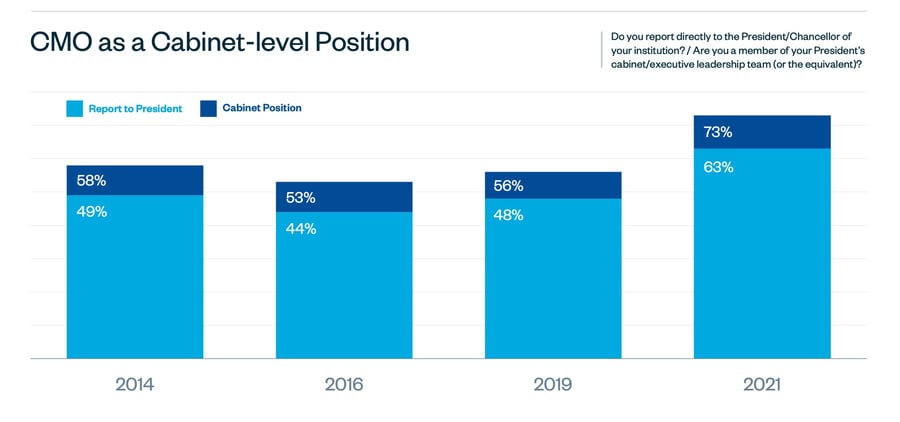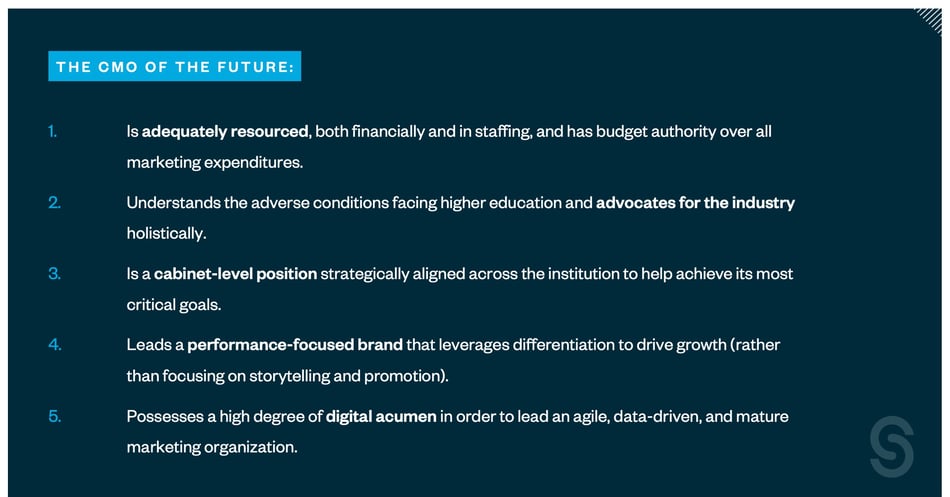Throughout much of the year, our team has been asking the question, "What's the future of higher ed marketing communications?"
We've shared ideas, perspectives, and research on what's contributing to the maturation of the practice. After all, across all industries, marketing has changed rapidly in the last decade. But in higher ed, that change was combined with significant shifts in demographics, diminishing enrollment, and growing public distrust — to say nothing of all the challenges forced on the industry by COVID-19.
In Performance Driven Brands, Pt. 1, I covered the environment that has led to a reality focused on performance-driven branding. The first key to achieving success is leading your institution to recognize the importance of marketing's role in achieving strategic institutional goals. Once over that hurdle, it's time to pounce on the two remaining pieces imperative to a strong marketing program: the never-ending quest for resources and a critical need to build deeper digital acumen.
I recently presented to senior marketing leaders at the AMA Symposium for the Marketing of Higher Ed session entitled CMO of the Future. And that conversation began with the elephant in the room—higher ed marketers don't have the resources or talent to meet the expectations within their own institutions. In our most recent CMO Study data, more than 70% of respondents indicated they did not have the budgets necessary to meet the expectations they face.
70% of higher ed CMOs report that they do not have the budget necessary to meet the expectations of institutional leadership.
The State of Budgets & Staffing in Higher Ed MarCom
In analyzing the data from our 2021-22 CMO Study, we first looked at trends by Carnegie Classification. Across the board, marketing leaders generally reported net increases to their budgets. But that all changed when we examined the data by tuition dependency. Highly tuition-dependent schools (defined as 67%+ of their operating budgets coming from tuition revenue, according to IPEDS) reported their budgets are down nearly 10% since our 2019 CMO Study. That's not even the most alarming figure — those same institutions are reporting staffing levels are down nearly 15%. Industry leaders are also keenly aware of the challenges they face amid "the great resignation," where they are losing top talent for a number of reasons.
Tuition-dependent institutions are reporting budget declines of nearly 10% and staffing declines of almost 15%.
If budgets are insufficient and talent is fleeing, we must work more efficiently. And this is where the current design of our organizations fails us. As our founder, Elizabeth Johnson is noted for saying, "organizational structure is the greatest barrier to integrated marketing and branding on college campuses." That's a reality many of us have lived for far too long, but centralization isn't a panacea either. Regardless of institutional profile, every school faces this challenge, and we often hear, "but we're really decentralized" as a badge of honor sometimes used to hide more resolvable shortcomings.
Respondents to our study reported that 73% of schools now have a senior marketing leader that sits on the university cabinet, and 63% report directly to a president or chancellor. While it's growth in the right direction, it's not nearly enough.

While higher ed slowly works to organize itself more efficiently and collaboratively, the corporate world continues to adapt to a rapidly changing world. According to a 2020 Gartner study, 25% of fortune 500 companies will have sales, marketing, and customer experience in a single department by 2023. Worth noting — the average fortune 500 company has more than 60,000 employees. Organizational changes of this scale are neither easy nor cheap. To have such a high rate of adoption on such an aggressive timeline indicates how necessary they are.
What would a similar organizational realignment look like for higher ed? Integrated marketing, enrollment, advancement, and student affairs units. It's hard to imagine that level of centralization occurring, so marketing leaders will need to continue to be coalition builders.
Better Partners Equals Better Results
Agencies and technology partners also bear responsibility for creating more effective partnerships alongside your efforts. For too long, partners have offered point solutions, happy to sell to anyone in the university willing to buy and not sharing responsibility for your performance goals.
Before coming to SimpsonScarborough, I oversaw marketing communications for the University of California system and was often frustrated at the amount of time I spent managing our agency and technology partners — in large part because of the number of single-problem solutions. That problem has grown exponentially over the years, relegating many talented CMOs and their staff to spend far too much of their time managing various vendor solutions. CMOs don't need more point solutions; they need more strategic partners who enable them to accomplish their strategic goals with increasingly constrained resources and staffing.
The Need for Digital Acumen
Regardless of reporting lines and centralization, it's clear that mature marketing operations must have leaders with a high degree of digital acumen to ensure their teams continually measure, iterate, and integrate. Data from our latest CMO Study reveals that just 3% of higher ed marketing budgets are spent on martech tools. Meanwhile, according to the latest Gartner CMO Spend Survey, martech accounts for 27% of total corporate marketing budgets. Not to belabor the point, but these budgets are also significantly larger both by volume and by the percentage of organizational revenue. Yet, even with nearly 9x the level of dedicated investment of higher ed, the CMOs in Gartner's survey reported they capture only 58% of their martech stack's capabilities. How much less effective are martech stacks in higher ed with significantly lower investments?
Just 3% of higher ed marketing budgets are spent on martech tools compared to 27% in the corporate world.
One of our benchmarks in assessing digital acumen is the integration between an institution's CMS and CRM. In our 2019 CMO Study, we found that only 32% of all institutions had these tools integrated, though an additional 35% planned to integrate them within the next 12 months. Yet, the State of Higher Ed Website & MarTech research data collected earlier this fall showed that only 35% of institutions reported these platforms were integrated in 2021.
The silver lining from that research is that there is no particular institution type that has an advantage over another in this arena. While there is an inextricable link between leadership and resourcing, those with both are better positioned than their counterparts. And that's good news because, with greater investment, a focus on digital transformation, and the right mix of staff and partners, a future in which you're truly able to measure and report on the impact of your work (rather than just the reach) is just on the horizon.
The Higher Ed CMO of the Future
In preparation for our presentation at AMA, we took this framework about performance-driven brands and combined it with the data and insights from our Web & MarTech research and our soon-to-be-released 2021-22 CMO Study, and drew some conclusions about what all of this means for the CMO of the future. After all, while we know that resources are a constant battle in higher ed marketing, they're still only one-half of the equation. Higher ed needs transformational leadership, and these are the qualities needed to not only endure the current levels of volatility but to leverage this moment to position the institution for success long term. Below are the five qualities we believe the higher ed CMO of the future must possess.

While full of challenges, higher ed marketers have made tremendous strides in professionalizing marketing within their institutions. I am proud that SimpScar stands alongside so many of the industry's best marketing leaders in championing the role and impact you have both on your campus and throughout higher education. Our hope is that the data from our research studies, articles and opinions, and impactful stories of success give you things you can use to make your case or inspire your efforts.
→ Download Jason's CMO of the Future Presentation
—
Jason is CEO & Partner at SimpsonScarborough. Before coming to SimpsonScarborough in 2014, Jason led the marketing communications teams for the University of California System and North Carolina State University. In 2013, he was named Higher Education Marketer of the Year by the American Marketing Association. Known for being our chief Peloton evangelist, he and his wife, Meredith, live in Oakland CA with their daughter, Amelia. Learn more about Jason here


%20(1).jpg)









